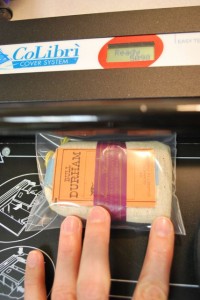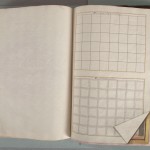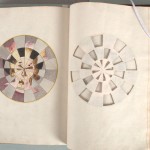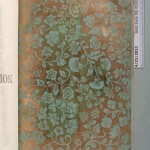What does it take to flatten photographs that are three or four feet long? A lot of press boards, bricks and weights, and an entire table.
Category Archives: Conservation
No Smoking In The Library (Plus a Lesson Learned)
 A couple of weeks ago we got a box from Technical Services labeled “tobacco samples.” Obviously, these needed something more than Zip Loc bags before going to the shelf.
A couple of weeks ago we got a box from Technical Services labeled “tobacco samples.” Obviously, these needed something more than Zip Loc bags before going to the shelf.
Still riding the success of boxing the Blue Devil, I got out the CoLibri pockets and enclosed each sample in a pouch. Then I made a blue-corrugated tray with multiple compartments to contain the various packages of tobacco.
The result: the tobacco is contained but accessible for viewing without all of the loose tobacco getting everywhere. The CoLibri pouches can be easily removed if we want to exhibit these items in the future, which was a concern for the archivists. Overall, I think this was another successful non-traditional use of CoLibri.
The Lesson Learned: I made this great container, with even more little dividers than the one in the image in order to keep all the tobacco safe from rolling around.
I was so proud of my solution and showed the box to everyone in the lab. They all smiled and praised their boss for actually making something. Then I tried to put the lid on the box….and I made the tray to fit the lid of the box rather than the base of the box. DOH! Humble pie, meet fork.
50,000 And Climbing
 It’s the end of the fiscal year and you know what that means…it’s statistics season! I’ve just finished compiling our FY2010-2011 stats and will now be subjecting them to feats of interpretation and contemplation.
It’s the end of the fiscal year and you know what that means…it’s statistics season! I’ve just finished compiling our FY2010-2011 stats and will now be subjecting them to feats of interpretation and contemplation.
Did you know:
- Since FY2003 we have repaired and bound over 50,000 books and pamphlets; we have also made over 51,000 custom enclosures.
- Last year we made 8,538 enclosures thanks in large part to the broadside project and the History of Medicine project.
- In FY2011, 57.7% of our work came from the Perkins Library system and 42.3% from Special Collections and Archives.
- About 78% of our output for the general collections last year was “shelf preparation” work including pamphlet binding, CoLibri covers, and pockets for books with CD’s.
- 90% of our output for special collections last year fits into the category of protective enclosures [see bullet #2 above].
I could go on and on, I love statistics as my staff will attest. What do these numbers mean? Several things which will become more apparent as I delve deeper into the meaning behind these numbers. One thing our data does say, our small staff is cranking out the work!
Image from the Emergence of Advertising In America 1850-1920 digital collection.
What We Find In Books: Fabulous Trompe L’oeil Dog Ears
Written by Erin Hammeke, Conservator for Special Collections.
This two volume set came through the lab recently for rehousing, and we were little prepared for what we found inside. The set is a from a small collection called the Jantz Early Manuscript Collection and little is known about it.
Both volumes are handwritten and illustrated and bound in wooden boards with blind-tooled leather covering. They appear to date from the 18th or 19th century. The texts seem to cover a variety of subjects from emblems to architecture and music to optics.
They contain a variety of different examples of decorated Dutch gilt paper bound in throughout the text. There are numerous hand-painted illustrations and the neatest ones involve cutouts that expose parts of the subsequent page. There is even a trompe l’oeil dog-eared page!
We look forward to learning more about this fascinating set.
Welcome to the Conservation Department: Grace White
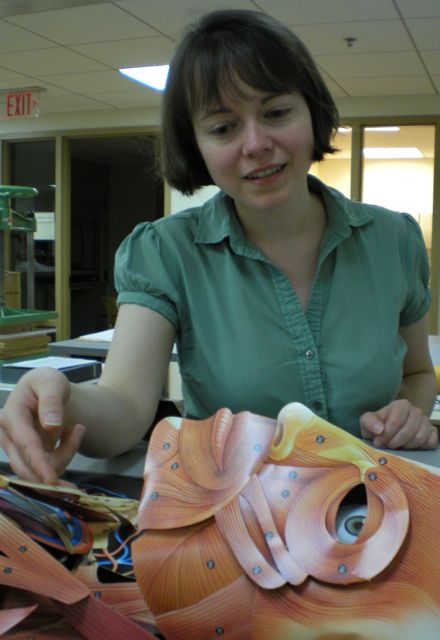 We have a new Special Collections Conservator on our staff! Grace White has joined our team.We are especially pleased to have her skills as a paper conservator added to our staff.
We have a new Special Collections Conservator on our staff! Grace White has joined our team.We are especially pleased to have her skills as a paper conservator added to our staff.
We look forward to giving her many challenges from our collections that just scream out for an expert in flat paper conservation (can you say “tons of adhesive tape on giant maps”?).
When asked about her favorite conservation project so far, Grace replied:
One of my favorite conservation projects was spending the winter in Alaska in 2009, traveling among museums that did not have their own conservation departments, in a project partially funded by AIC and the Rasmuson Foundation of Alaska.
I visited beautiful Fairbanks, where I worked at the Museum of the North at the University of Alaska at Fairbanks; remote Eagle, a tiny town of less than 100 people during winter, accessible only by plane but full of history and an impressive archive; and Barrow, the northernmost city in mainland North America and home to the Inupiat people as well as polar bears, snowy owls and arctic foxes.
I walked on the frozen ocean, saw the northern lights, ate reindeer, learned to snowshoe, and watched a dog sled race, as well as treated many paper and vellum artifacts and taught museum staff, students and the public about conservation. The work was a challenge, so far away from the conservation supplies and equipment I’m used to having, but I loved the experience!
Grace holds a BA in English with a minor in Art from Covenant College. She earned an MA in Conservation of Fine Art, Works on Paper from Northumbria University (Newcastle upon Tyne, UK). Upon graduation in 2002 she went to work for Etherington Conservation Services in Greensboro, North Carolina.
Welcome to our team, Grace!
Welcome To Our New Staff: Jennifer Blomberg
 Jennifer Blomberg has joined the DUL Conservation Department as our technician for special collections. She has been with us since February 2011, and has already made over 700 custom enclosures! I’ve promised her some repair work, too, not to worry.
Jennifer Blomberg has joined the DUL Conservation Department as our technician for special collections. She has been with us since February 2011, and has already made over 700 custom enclosures! I’ve promised her some repair work, too, not to worry.
When asked to describe one of her favorite conservation projects, she answered:
The “Herbert Sondheim Company” scrapbook of fashion drawings from the Fashion Institute of Technology has been one of my most favorite conservation treatments to date. Herbert Sondheim ran a dressmaking company that made affordable versions of high-end fashion.
These drawings, many of which are hand-colored on thin tracing paper, date from the 1920’s to the 1940’s and depict works of Vionnet, Chanel, Molyneux and other noted designers. Not only are the drawings visually interesting, the treatment offered many challenges that included collation, systematically removing the drawings from the acidic scrapbook pages without disturbing the water soluble inks, mending and flattening the sketches, and re-housing.
Jennifer has a Bachelors of Fine Arts in Conservation with a concentration in Collections Care, along with minors in Art History and Fine Arts from the University of Delaware. She is currently pursuing a Masters of Library and Information Science from the University of Pittsburgh School of Information Sciences. She is earning her MLIS with a specialization in Archives, Preservation, and Records Management. Prior to coming to Duke Jennifer was a Conservation Technician at the Conservation Center for Art and Historical Artifacts in Philadelphia, PA.
Welcome to Duke Jennifer!
Quick Pic: A mind of its own
Repairing de Bry, One Piece At A Time
Written by Erin Hammeke, Conservator for Special Collections.
I recently completed the treatment of three separate volumes from Theodor de Bry’s account of the Americas, and I thought I would share an anecdote from the treatment of one of the volumes, Das vierdte Buch von der Neuwen Welt (Frankfurt, 1594).
 This item has an engraved map of the Florida coast and Gulf of Mexico bound in at the front of the text. The curators informed me that this map was missing about a half of the complete printed map, the whole right side. They felt that it would be useful to indicate to researchers just how much of the map was missing by doing a repair and fill to the original dimensions of the plate.
This item has an engraved map of the Florida coast and Gulf of Mexico bound in at the front of the text. The curators informed me that this map was missing about a half of the complete printed map, the whole right side. They felt that it would be useful to indicate to researchers just how much of the map was missing by doing a repair and fill to the original dimensions of the plate.
An interesting thing happened. There was a small fragment, apparently tucked in with the map that I assumed belonged along the torn edge, but upon closer inspection, did not appear to line up with any part of the map along that edge.
Lucky for us, UNC Wilson Library has a version of this volume with a complete map. We contacted our conservation colleagues at UNC and arranged to see the map at their conservation lab. I took an image of the fragment with me to see if we could place it while we were there, but we couldn’t, so, we took a digital photograph of their map in its entirety and headed back to our lab.
I blew up the digital image and printed it out to the actual dimensions of the original, and I superimposed this printout onto our partial map on a light table. I was surprised to find that the small fragment actually belonged near to the center of the missing portion of the plate.
After some head-scratching, the curators and I decided that it was best to adhere the fragment in its rightful place. Again, using the light-table and printout as a guide, I adhered it precisely where it belonged.
I was pleased to be able to share this project with scholars who use these works at a recent symposium dedicated to the latest issue of the Journal of Medieval and Early Modern Studies. And I am happy to say that all three of the treated volumes were recently digitized by the Digital Production Center and are now available through the library’s catalog.
Here is a picture of the map after washing, lining, repairing, and adhering the loose fragment with paste.
Quick Pic: The boxing workflow
Preservation Video Rodeo Roundup, pt. 5 (The Rest of the Videos)
Welcome to the final day of our Preservation Week video rodeo roundup. Today is a grab bag of preservation and conservation related videos, and a couple plain ol’ library videos, that we like. If you have found others you like that are in this same genre, please leave a link in the comments.
Book artist and author Bea Nettles on learning about preservation and how it has changed her work.
httpv://www.youtube.com/watch?v=UE0cx4gM_fo
LYRASIS (formerly SOLINET) shows you how to safely remove a paperclip. I know you want to send this to all of your processors, don’t you? They will also show you how to remove staples.
httpv://www.youtube.com/watch?v=hI27vwFuEjM
Library security from the T.C. Beirne Law Library at the University of Queensland, Australia.
httpv://www.youtube.com/watch?v=WsRNYIdiVdE
Just for fun: In 2009 to take a break from studying, an estimated 3,000 students created a flashmob at the UNC Chapel Hill Davis Library. Hmmm, today is the last day of classes here, I wonder if our students will do something like this?
httpv://www.youtube.com/watch?v=faXpUBgQnd8



